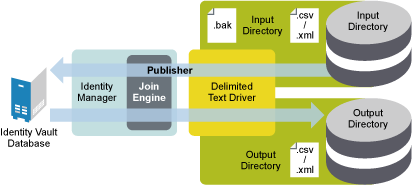1.2 Driver Concepts
1.2.1 Java Interfaces to the Driver
The Delimited Text driver includes four Java* interfaces that enable you to add extensions, which are optional. These enhancements to the driver require Java programming. For more information, see Using Java Interfaces to Customize File Processing.
1.2.2 How the Delimited Text Driver Works
The Delimited Text driver uses the Publisher channel, the Subscriber channel, and policies to control data flow.
Publisher and Subscriber Channels
The Delimited Text driver supports the Publisher and Subscriber channels:
-
The Publisher channel reads information from input text files on your local file system and submits that information to the Identity Vault via the Metadirectory engine.
By default, the Publisher channel does the following:
- 1. Checks the input directory every 10 seconds.
- 2. Processes any files that have a .csv extension.
- 3. Changes .csv extensions of processed files to .bak.
- 4. Cycles through this process until you stop the driver.
-
The Subscriber channel watches for additions and modifications to Identity Vault objects and creates output files on your local file system that reflect those changes.
By default, the Subscriber channel keeps an output file open until either 200 transactions have been logged or 30 seconds have elapsed. When either of these thresholds is reached, the output file is saved with a number.csv filename and a new output file is opened.
Figure 1-1 Data Flow

The example configuration that ships with this driver includes both Subscriber and Publisher channels. However, in many configurations, only one-way data flow is required. In those configurations, only a Publisher or Subscriber channel is used. The other channel is disabled.
Policies
Policies control data synchronization between the driver and the Identity Vault. The following table provides information on the set of preconfigured policies that come with the Delimited Text driver. To customize these policies, use Novell® iManager, as explained in Configuring the Delimited Text Driver.
Table 1-1 Preconfigured Policies